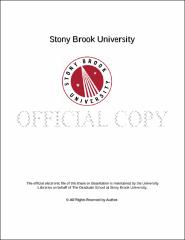| dc.identifier.uri | http://hdl.handle.net/11401/77111 | |
| dc.description.sponsorship | This work is sponsored by the Stony Brook University Graduate School in compliance with the requirements for completion of degree. | en_US |
| dc.format | Monograph | |
| dc.format.medium | Electronic Resource | en_US |
| dc.language.iso | en_US | |
| dc.publisher | The Graduate School, Stony Brook University: Stony Brook, NY. | |
| dc.type | Thesis | |
| dcterms.abstract | Ocean acidification has been shown to endanger shelled marine organisms, since increased CO<sub>2</sub> intake by oceans will decrease pH of seawater and enhance Ca<super>2+</super> dissolution from shell skeletons. Determination of Ca<super>2+</super> concentration in the marine environment would not only help to provide information about local calcium ion distribution and activities, but also provide a sketch of the living condition of shelled marine organisms. A number of optical sensors for calcium ion detection have been developed. However, these detectors were mostly designed for intracellular detections or relatively low ion concentration conditions (10<super>− 6</super> to 10<super>− 8</super> M) and have high calcium affinity, which is not suitable to apply in a marine environment where calcium concentration is much higher (∼ 10mM). The objective of this project is to develop a fluorescence-based calcium sensor with low calcium affinity for calcium distribution imaging in marine environments. The synthesis of this sensor is the first step towards the development of an optical instrument for direct in situ, non-destructive and high-resolution two dimensional imaging of Ca<super>2+</super>. The experimental approach involves the coupling of a fluorophore with a calcium binding ligand. When binding to calcium ions, the fluorescence of the sensor will increase and hence shows correlation to calcium concentration in the sample. Further steps include verification of the coupling product, examination of the calcium ion binding ability, and possibly the application in artificial marine settings. | |
| dcterms.available | 2017-09-20T16:51:59Z | |
| dcterms.contributor | Drueckhammer, Dale G | en_US |
| dcterms.contributor | Goroff, Nancy | en_US |
| dcterms.contributor | Koch, Stephen. | en_US |
| dcterms.creator | Huang, Jingyu | |
| dcterms.dateAccepted | 2017-09-20T16:51:59Z | |
| dcterms.dateSubmitted | 2017-09-20T16:51:59Z | |
| dcterms.description | Department of Chemistry. | en_US |
| dcterms.extent | 65 pg. | en_US |
| dcterms.format | Application/PDF | en_US |
| dcterms.format | Monograph | |
| dcterms.identifier | http://hdl.handle.net/11401/77111 | |
| dcterms.issued | 2015-08-01 | |
| dcterms.language | en_US | |
| dcterms.provenance | Made available in DSpace on 2017-09-20T16:51:59Z (GMT). No. of bitstreams: 1
Huang_grad.sunysb_0771M_11485.pdf: 1536883 bytes, checksum: 1592baa877f86f6c80be76a00e81b86d (MD5)
Previous issue date: 2013 | en |
| dcterms.publisher | The Graduate School, Stony Brook University: Stony Brook, NY. | |
| dcterms.subject | Chemistry | |
| dcterms.title | Synthesis of a Fluorescent Sensor for Calcium Measurement in Marine Sediments | |
| dcterms.type | Thesis | |

